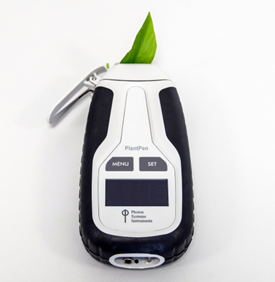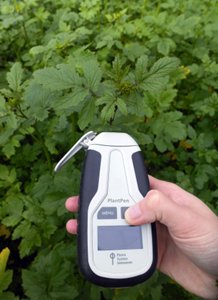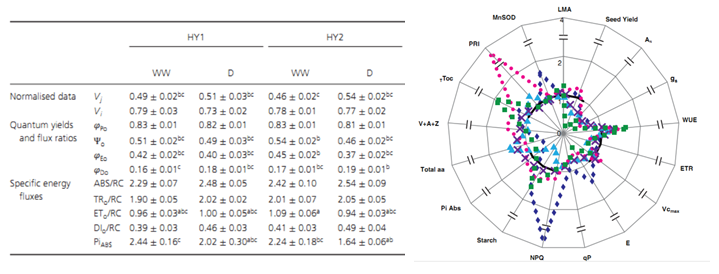PlantPen叶夹式PRI&NDVI测量仪
PlantPen叶夹式PRI&NDVI测量仪是一种快速测量植物反射光谱指数的野外便携式仪器。PlantPen的两种标准版配置分别测量NDVI和PRI这两种应用为广泛的植被指数。用户也可以定制其他参数。
PlantPen PRI 210:PRI (Photochemical Reflectance Index) 光化学反射指数是通过计算植物叶片对531nm和570nm两个波长光反射而得到的参数。该参数对类胡萝卜素极为敏感,反应植物的光合作用中的光能利用效率和CO2同化速率,并可作为植物水胁迫的可靠指数。因此广泛用于植物产量和胁迫研究。
 PlantPen NDVI 310:NDVI (Normalized Difference Vegetation Index)归一化植被指数是通过计算植物叶片对红光和近红外两个波长光反射而得到的参数,是反映植物叶绿素含量的一个重要参数。叶绿素会强烈吸收红光用于光合作用,而叶片细胞结构会强烈反射近红外光。因此,NDVI与光合能力直接相关,从而反映植物冠层的能量吸收状况。
PlantPen NDVI 310:NDVI (Normalized Difference Vegetation Index)归一化植被指数是通过计算植物叶片对红光和近红外两个波长光反射而得到的参数,是反映植物叶绿素含量的一个重要参数。叶绿素会强烈吸收红光用于光合作用,而叶片细胞结构会强烈反射近红外光。因此,NDVI与光合能力直接相关,从而反映植物冠层的能量吸收状况。
应用领域
叶绿素含量快速检测
植物光合研究
早期胁迫检测
氮素利用效率研究
功能特点
携带方便、操作简单。
直接无损测量得到NDVI和PRI值。
内置蓝牙与USB双通讯模块,内置GPS模块,输出带时间戳的地理位置
软件可导出数据为Excel格式,具备实时控制和遥控功能。
可用于农业、林业以及植物学中光合作用、逆境胁迫等的研究和教学。
技术参数
 测量参数:PlantPen PRI 210:光化学反射系数PRI = (R531 - R570)/(R531 + R570);PlantPen NDVI 310:归一化植被指数NDVI = (RNIR – RRED) / (RNIR + RRED)
测量参数:PlantPen PRI 210:光化学反射系数PRI = (R531 - R570)/(R531 + R570);PlantPen NDVI 310:归一化植被指数NDVI = (RNIR – RRED) / (RNIR + RRED)
测量光:内置双波长光源,PlantPen PRI 210:531nm和570nm;PlantPen NDVI 310:635nm和760nm
检测波长:PlantPen PRI 210:500 – 600 nm;PlantPen NDVI 310:620-750 nm
通讯:蓝牙+USB双通讯模式,蓝牙在20m距离ZD传输速度3Mbps
GPS模块:内置,ZG精度1.5m
存储:16Mb
数据存储:100,000个数据点以上
显示:图形显示
键盘:密封防水设计2键
电源:2000mA可充电锂电池,USB充电,连续工作70小时,低电报警
自动关机:5分钟无操作
 尺寸:135×65×33 mm
尺寸:135×65×33 mm
重量:188g
操作环境:温度: 0 ~ 55 ºC; 相对湿度: 0 ~95 % (无冷凝)
存储条件:温度:-10 ~ 60 ºC;相对湿度:0 ~ 95 % (无冷凝)
用户定制
描述植物结构和叶绿素含量的参数种类很多,应用测量光波长各异,计算方法也各不相同。为了满足不同客户的需求,可以定制适合各种类似参数的掌上植物测量仪。或购买PolyPen RP410光谱仪测量植物全反射光谱。
应用案例

西班牙巴斯克大学使用PlantPen PRI测量仪和FluorPen叶绿素荧光仪研究高产大豆对干旱胁迫的生理和光合响应(Buezo,2019)。

沈阳农业大学使用PlantPen NDVI 和SpectroSense 2+植被指数测量仪分别测量水稻叶片和冠层的NDVI(Y Fenghua, 2016)
产地:捷克
参考文献
1.Cortinhas, A., Caperta, A. D., Teixeira Ra, G., Carvalho, L., & Abreu, M. M. (2020). Harnessing sediments of coastal aquaculture ponds through technosols construction for halophyte cultivation using sing saline water irrigation. Journal of Environmental Management, 261, 109907.
2.Rossini-Oliva, S., Abreu, M. M., Sanantos, E. S., & Leidi, E. O. (2020). Soil–plant system and potential human health risk of Chinese cabbage and oregano growing in soils from Mn-and Fe-abandoned mines: microcosm assay. Environmental Geochemistry and Health.
3.Raminoarison M, et al. (2020). Multiple-nutrient limitation of upland rainfed rice in ferralsols: a greenhouse nutrient-omission trial. Journal of Plant Nutrition 43(2): 270-284
4.Jabran K, et al. (2020). Elevated CO2, temperature and nitrogen levels impact growth and development of invasive weeds in the Mediterranean region. Journal of the Science of Food and Agriculture.
5.Buezo J, et al. (2019). Drought tolerance response of high‐yielding soybean varieties to mild drought: physiological and photochemical adjustments. Physiologia Plantarum 166: 88–104
6.Chen S., Guo Y., Sirault X., et al. (2019). Nondestructive Phenomic Tools for the Prediction of Heat and Drought Tolerance at Anthesis in Brassica Species. Plant Phenomics, 16
7.Lv X., Zhang Y., Zhang Y., et al. (2019). Source-Sink Modifications Affect Leaf Senescence and Grain Mass in Wheat. bioRxiv 647743.
8.Paterson, I. D., Coetzee, J. A., Weyl, P., Griffith, T. C., Voogt, N., & Hill, M. P. (2019). Cryptic species of a water hyacinth biological control agent revealed in South Africa: host specificity, impact, and thermal tolerance. Entomologia Experimentalis et Applicata.
9.Ruiz De Larrinaga, L., Resco De Dios, V., Fabrikov, D., Guil-Guerrero, J. L., et al. (2019). Life after Harvest: Circadian Regulation in Photosynthetic Pigments of Rocket Leaves during Supermarket Storage Affects the Nutritional Quality. Nutrients, 11(7), 1519.
10.K Jabran, et al. 2018. High carbon dioxide concentration and elevated temperature impact the growth of weeds but do not change the efficacy of glyphosate. Pest Management Science 74(3): 766-771
11.K Trnková, et al. 2017. Desiccation‐induced changes in photochemical processes of photosynthesis and spectral reflectance in Nostoc commune (Cyanobacteria, Nostocales) colonies from polar regions. Phycological Research 65(1): 44-50
北京易科泰生态技术有限公司
仪器网(yiqi.com)--仪器行业网络宣传传媒